
From left: Jason Nelson, Susie Fawcett, Christin Lipinski, Isabella McCune, Isla Cook, Hailey Boyce, Stephanie Nielson and Christian Nielson stand by Machame Gate on the first day of their hiking journey to the peak of Mt. Kilimanjaro. Valleywise Health Foundation
On the first day of his long ascent to the top of Mount Kilimanjaro, Dr. Kevin Foster was surrounded by a tangle of green.
He had swapped his scrubs for hiking gear and exchanged a busy hospital ward for the lush tropical rain forest blanketing the base of Africa's highest peak.
He had been walking uphill through the dense, humid foliage for hours.
As he hiked, an unsettling sentiment flickered across his mind.
This is going to be a lot harder than I thought.
Foster, who is 61, is no stranger to tough journeys. But he is usually helping others through them.
As director of the Arizona Burn Center, a position he has held since 2002, Foster has cared for people with injuries near inconceivable to those who haven’t lived them.
Recovering from a bad burn, he says, is “almost like a siege.” And Foster has led thousands of them within the hospital’s beige and pale pink corridors.
Still, he says: “I can’t imagine what it’s like.”
With him on the trail ascending Kilimanjaro that day were eight people who can.
The survivors were different ages, from different walks of life. They had suffered their life-changing injuries in different ways: a plane crash, a structure fire, an infection of rare flesh-eating bacteria, a fire pit, a propane tank, a natural gas leak, a vape explosion.
But they had in common a long, tough recovery at the Arizona Burn Center in downtown Phoenix. There, they had lain in medically-induced comas. Endured unrelenting pain. Learned to walk again. Confronted their adjusted futures.
And eventually, bearing scars they would manage for life, they had been discharged.
Now they sought to climb Mount Kilimanjaro.
The imposing mountain reaches 19,341 feet into the skies above northern Tanzania, east of the Serengeti plain. It is an aggregate of three volcanoes, two of them extinct and the tallest, Kibo, dormant, with the potential to erupt again. On the rim of Kibo's crater is the summit peak, Uhuru, the Swahili word for freedom.
The survivors would journey there along the Machame Route, a 37-mile walk that winds through the rain forest before emerging onto a plateau, guiding hikers through a rocky landscape dotted with otherworldly, hydra-headed trees, and onward up to the summit.
On June 17, when the survivors set off, Kilimanjaro's snow-capped peak was hidden from view.
That first day, they had to walk seven miles. Foster knew that in Phoenix, that distance would take him two and a half hours, max.
But eight hours after stepping out on the Machame Route, the doctor and his former patients were still going.
Foster wasn't worried they would get hurt. As mountains go, Kilimanjaro is not a dangerous climb for people who come prepared, who hike with a guide and keep a careful watch for altitude sickness.
He was worried the survivors might not be able to do it.
As he toiled through the jungle, another thought flashed by.
I may have made a really terrible error.
The survivors
Christian and Stephanie Nielson met in 2000 in her hometown of Provo, Utah, where he was attending Brigham Young University. Four months after their second date, they were married.
"We just fell in love," Stephanie says. "And that was that."
By 2008, when the accident happened, they had moved to Mesa and were parents to four children: a first grader, a kindergartener, a three-year-old and an 18-month-old.
On August 16, 2008, the Nielsons were aboard a light Cessna aircraft piloted by Christian when trouble struck after take-off and they plummeted to the ground.
Badly burned, the Nielsons were rushed to the burn center and remained there until November, when Christian was discharged to a rehab center and Stephanie, burned over 83% of her body, was transferred to a different burn center in Utah.
It was a long — very long — road to recovery. But slowly, the Nielsons returned to life. They were able to take care of their children again, and even added another to their family. They now live in North Carolina, and say their faith in God was an integral part of their healing.
In January 2020, just before the pandemic turned everything upside down, Christian got a call.
On the other end of the line was Nate Lowrie, CEO of the Valleywise Health Foundation. Together with Dr. Foster, he had been dialing burn survivors to ask a pretty big question.
Want to go to Tanzania and hike Mount Kilimanjaro?
'Absolutely yes to everything'
“He gave a really nice pitch,” Christian remembers.
The hike would involve community service in Tanzania, visiting a hospital and orphanage and bringing toys and sports equipment to a school. It would demonstrate what people can achieve after burn trauma.
And it would be a fundraiser for the brand new burn center, which is currently under construction and set to open in October 2023. The Diane and Bruce Halle Arizona Burn Center will bring all facets of burn care together on one floor of the new Valleywise Health hospital.
In the current hospital, built in 1971, the center is geographically scattered. The new unit will boast a pediatric wing and an area dedicated to outpatient therapy, physical and psychological.
“I said ‘Nate, absolutely yes to everything,’” Christian says.
“Yes to everything you just said, yes to Tanzania, yes to the new hospital, yes to anything we can do for the burn center and Dr. Foster and Valleywise, it's a yes."
The Nielsons were all in.
Six other survivors got the same call, and one by one, they said yes.
'I thought I'd never walk again, let alone hike'
Jason Nelson spent six months in the burn center after a natural gas explosion in Gilbert in 2014. He had been an avid hiker before the accident, climbing the Grand Canyon a couple of times.
But when he was in the center, recovering from burns to 80% of his body, it all seemed so far away.
"I thought I'd never walk again, let alone hike," he says.
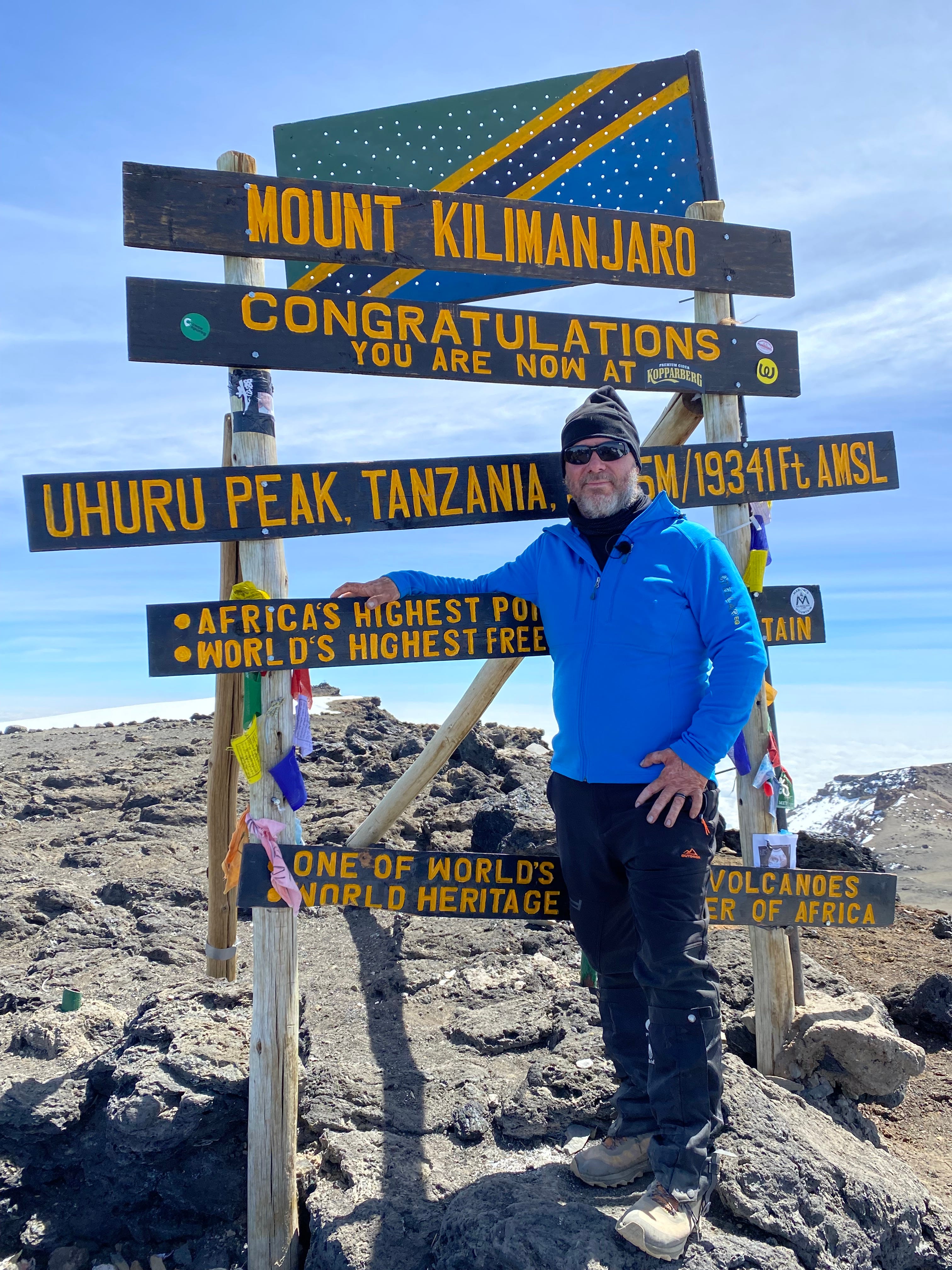
When Foster rang in early 2020 with the Kilimanjaro plan, Jason felt motivated to return to his old hobby.
"It kind of gave me a new purpose," he says.
Christin Lipinski, a Peoria teacher and mom of three, spent two and a half months in the center after contracting necrotizing fasciitis in January 2018. The rare bacterial infection, which rapidly kills tissue and can be fatal, is among the severe skin diseases also treated at the center.
After being discharged, she returned as a volunteer, supporting others with necrotizing fasciitis.
When Foster called with the "crazy idea" of climbing Kilimanjaro, Christin was thrilled to be asked, doubly so when she discovered it was a fundraiser for the new center.
"What they were able to do in the little facilities that they have had all these years is amazing, so what they could do with bigger and better facilities?" she says. "It's just beyond words."
There was also Isla Cook, the youngest climber at 11, who would hike alongside her mother. The talented gymnast was burned in June last year when a propane tank went up in flames at a family gathering.
Hailey Boyce, who was 17 when her vape exploded in 2016, burning her badly, would go.
So would Susie Fawcett, a Phoenix fire captain and high school swim coach burned during a structure fire in 1998.
And Isabella McCune, 12, who set a record with her stay at the burn center. She was in the hospital for 276 days, just over nine months, recovering from burns to 65% of her body from a fire pit accident on St. Patrick's Day 2018.
She got the invitation to Tanzania via voicemail, after missing Dr. Foster's call.
"My initial reaction was like, what, of course, yes! This is crazy, are you kidding? Of course I want to go," she says. "So I was immediately like, yes yes yes.”
The eight survivors would be joined by Valleywise Health Foundation and hospital staff, as well as community supporters. All told, 47 people would tackle the mountain, led by Scottsdale company K2 Adventure Travel and accompanied by dozens of porters to carry gear — though, more on that later.
The tight-knit group was known as Team Courage Rising.
It was a company Stephanie and Christian Nielson could not have imagined in the immediate wake of their accident.
All we want to do is help other burn survivors who are in the ICU, and show them that there's a good life to be lived after the trauma.
At first, once they were able to take in their injuries, they did not want to be part of the burn survivor community.
"We were scared of other burn survivors," Christian says.
"I think for a long time that we were in denial," Stephanie adds. "I was. I was like, 'I'm not a burn survivor. I'm going to get over this and I'm going to be fine.'"
It took a while. But once they came around, they never looked back.
"All we want to do is help other burn survivors who are in the ICU, and show them that there's a good life to be lived after the trauma," Christian says.
Climbing Kilimanjaro would be a pretty great way to do that.
Isabella's story: Badly burned girl hopes to meet Taylor Swift after taking strength in her music
Getting ready to go
Isabella McCune had been on a plane just once before, a short hop from Phoenix to Sacramento.
The trip to Tanzania introduced a dizzying number of firsts for the middle-schooler. "First time overseas, first time out of the country, first time away from my parents," she recites, with a huge smile.
Not to mention this confession: "I didn't really even like hiking before."
The trip was meant to happen in September 2020, but was postponed due to the pandemic. In the meantime, Team Courage Rising practiced on local peaks.
They conquered the metropolitan mainstays of Camelback and Piestewa. Cast their eyes over Sedona's red rocks from the top of Bear Mountain. Trekked to the top of Humphreys Peak near Flagstaff, the highest point in Arizona at 12,633 feet.
All that hiking was a new thing for Isabella. But, she says, it was all worth it.
"If I didn't do this training and I wasn't motivated to keep going with it I don't think I would have made it very far in Kili, so..."
The long delay had another benefit.
"It was kind of like a blessing that we got postponed so much because we got to be together so much more and all watch each other grow from where we started," Isabella says.
"It was really nice to be able to get so close for Africa."
It wasn't just the other survivors Isabella felt close to. When she was rushed into the hospital, a physical therapist named Danika Hines had just returned from maternity leave.
She heard a badly burned girl, just 8 years old, had been admitted and went in to see her.
"I just remember seeing her face and her looking at me and mouthing 'help me' over her tube," Danika says.
"And I was like, 'yeah, of course we're going to help you, sweetie.'"
It was an instant attachment, Danika says, “especially after having a daughter myself."
She became Isabella's primary therapist during her nine-month hospital stay. Danika was constantly by her side, guiding her through dressing changes and gently bending and stretching Isabella's legs as she slept under anesthesia for her numerous skin graft surgeries.
Eventually, Danika helped Isabella get out of bed, sit on a wheelchair and walk. After Isabella was finally discharged, Danika did her outpatient therapy for six months.
Isabella's burns were so extensive and so painful that physical therapy was very difficult. But she has nothing but gratitude for Danika.
“She obviously wouldn't want to hurt me,” Isabella says. “But she was trying to do it to help me. And afterwards she would tell me, I wouldn't do this if I didn't think it was going to help you.”
“So even though it would be painful and sometimes would be kind of hard for me to keep pushing, she would always be there and give me that extra little push, little nudge, be like, you can do it.”
When Isabella needed a guardian by her side all the way up to Uhuru Peak, her mom knew who to ask.
Recovery: Months ago, this Taylor Swift superfan could barely stand. Now, she wants to dance
Ascending the summit
On the first day of the hike, traveling through an abundant rain forest flush with damp moss and ferns, Christin Lipinski was filled with wonder.
"You know, we're desert rats here (in Arizona)," she says. "So to be able to see as much green as we saw, that was one of my most favorite parts."
The next day, the terrain was tough, all up — and at least partly reminiscent of home.
"Imagine going up Camelback Mountain or Piestewa Peak, and multiply times three," she says.
“We just kept climbing and climbing and climbing.”
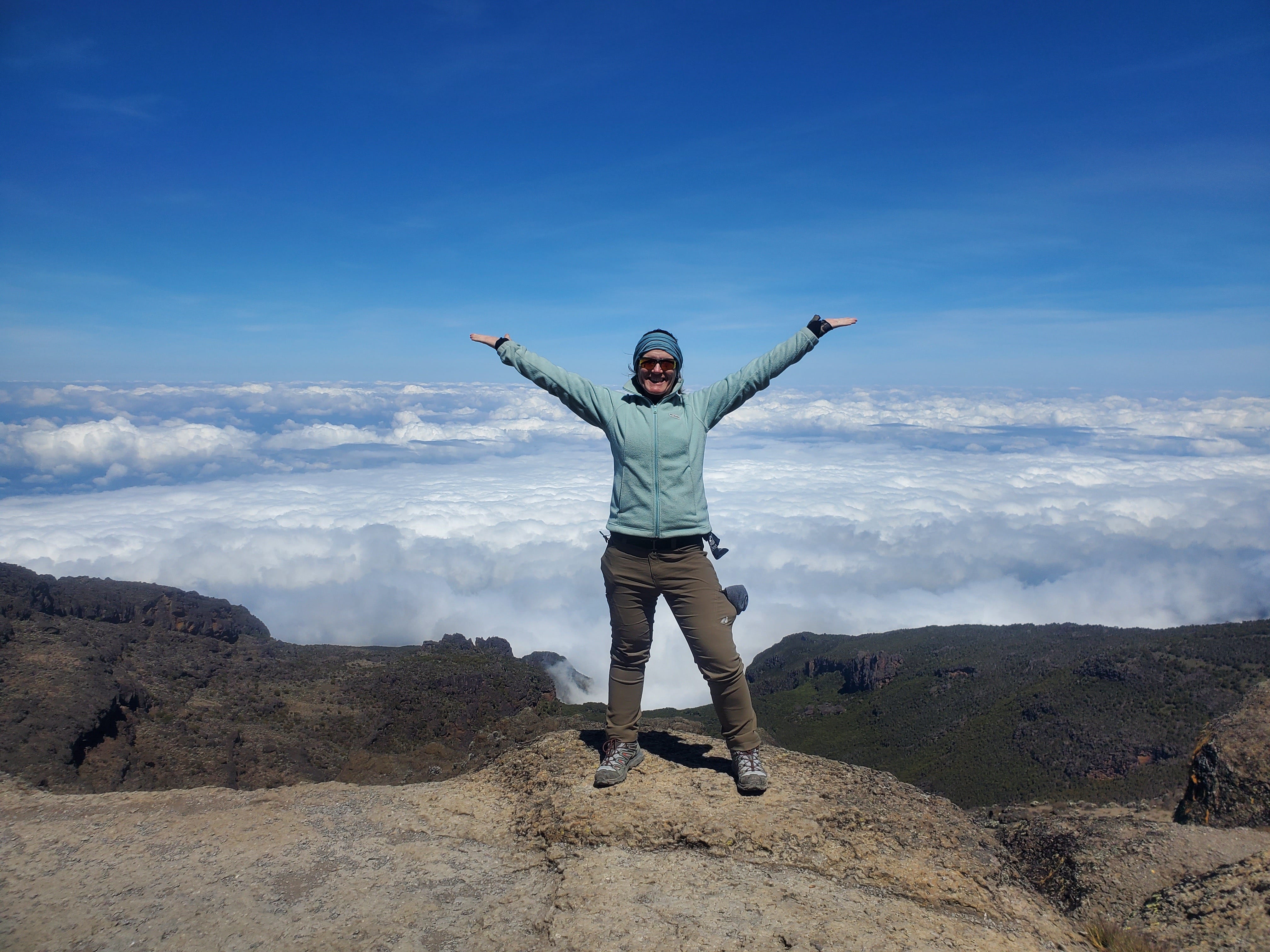
There were long, tough days on the mountain. But Christin had a not-so-secret weapon.
Her necrotizing fasciitis infection was the most painful thing, in body and mind, the special education teacher had ever endured.
"You know, my family almost lost me. I was in a coma for 24 days," she says. "I was going into septic shock and they were in the middle of trying to save me in the emergency surgery. My arm could have been amputated.
"There's so many things that if it went one way, it would have been catastrophic."
Recovery was still horrifying: donor sites that felt like they were on fire, the frustration of waiting to see if grafts would take, and the loneliness of feeling like she was the only person going through it all.
When Christin emerged from her medically-induced coma, she suffered from brain fog and her muscles had deteriorated. She had to build the strength to walk again.
"Taking that first step, I felt like I weighed 500 pounds and just having to lift my leg was just such an ordeal," she says.
But all of that became fuel as she pushed herself towards the summit.
"Going up in the elevation and you're feeling that gravity pushing you down and you're having to walk like a sloth, you think, okay, yeah, this is awful," she says.
"But then you go back to, well, I remember taking that first step and that was even worse.
"So OK, you got this. And this is a prettier view. So get over it and just keep on moving.”
The survivors sometimes reminisced about their hardest days as they climbed. Many of the conversations were about dressing changes, Christin says, the invasiveness and extreme pain of having bandages that had adhered to your wounds stripped off of you.
Sometimes, tears would flow as they remembered what they had been through.
"I just kept kind of reliving it and definitely had some emotional moments, especially with my fellow survivors, just being really grateful that we were all there to experience this," Christin says.
"You know, all of our situations were different, but they all could have gone that different direction and we wouldn't be there. And so that definitely would choke me up at moments."
So, yes, there were some hard days on the mountain, but it was nothing the survivors couldn't handle.
On the second day, as Christin felt like she was endlessly scaling a greener version of Camelback Mountain, the group was suddenly shrouded in fog.
"Wow, we're getting some weather here," Christin said.
For Isabella, the mist was lovely, cool refreshing droplets spraying onto her face like the ubiquitous misters on Phoenix restaurant patios.
"And then all of a sudden you're at the top, you turn around and you realize," Christin says. "Oh, my gosh."
They had just walked through the clouds.
Christin's son had asked her to bring home a cloud for him, so she filmed videos trying to grab onto the elusive fog.
Their camp was just above the clouds, a fluffy white sea stretching to the horizon and beyond.
In front of them, Kilimanjaro's snowy peak was visible for the first time.
Reaching Uhuru Peak
Team Courage Rising was 45 minutes from the summit, taking a break at Stella Point, when Isabella had a moment.
She knew how close they were. She had passed a pulse oximeter test, making sure it was safe to keep going up. But still, the altitude was getting to her. She felt drained.
She knew she could get up to the summit and then back to Stella Point. But after that loomed the rest of the day: walking back to camp, packing up gear, and descending another 7,000 feet.
Isabella felt like she couldn't do all that. She started to cry, panicking. "I don't know if I can do it, I'm scared," she told Danika.
And — not for the first time — Danika knew she had to push Isabella to keep going.
"I'm like, 'No, you're absolutely going to make it back down,'" Danika recalls.
She reminded Isabella she didn't have to do it on her own. Danika was there to help, and so were two porters. The man assigned to Isabella had young kids, and had taken a shine to her.
"Between the four of us, we're all going to get down just fine, sweetie," Danika told Isabella.
And they kept going up the mountain.
Finally, a sign came into view.
It was made of wooden posts with planks bolted to them, welcome words carved into the wood. "Congratulations," it read. "You are now at Uhuru Peak, Tanzania, 5895m/19341ft."
As Isabella approached, she met eyes with Christin. Their stays in the burn center had briefly overlapped.
"I went to visit her a couple of times," Christin says. "I had been discharged from the hospital that year while she was still there, and I just really fell in love with her and her mom. And I was really excited to hear that they were part of the team.
"And we had been in it from the very beginning, the two of us, along with Jason Nelson. And so we had gotten really close. All those training hikes."
They had come out of the burn center. Conquered peaks across Arizona. And now they were standing on top of Kilimanjaro.
"Don't look at me like that, you're going to make me cry," Isabella told Christin.
Christin said the same thing back.
And then they embraced, tears rolling down their cheeks.
"We were both crying because we were happy and we were so proud of each other," Isabella says.
It was a profound moment for her.
"I wanted to do this to show that even after something so horrible happening to me, and even after I had to go through that for all those nine months, I still came back, and I'm still doing everything I can to get better, " she says.
Isabella knows she will wear her scars for the rest of her life. She manages them with lotion, massage, and stretching. She has had laser procedures and one release surgery to loosen the tissue, and will have to undergo more.
The scars will never disappear, but they won't stop her from getting on with life. She hopes people who have recently sustained burn injuries will hear about the Kilimanjaro trip and find hope in their own journey.
"Because I know there are times in the hospital when you feel like you won't even make it through," Isabella says.
"You're feeling so put down and you feel so, almost like, I know there were some points for me where I felt almost alone. Even though I knew I had my mom and my dad and such an amazing support system I didn't have anyone I could relate to with the accident."
That's why she wants to be a burn nurse.
To show her scars to people who have been burned, and tell them, this happened to me when I was 8 years old, and I got through it, and you can too.
The lessons of the summit
Standing on the summit, Stephanie Nielson felt full of possibility.
I did this. Now I can do anything.
There were some moments of self-doubt during the hike. A day of discomfort when the scars around her ankles — a band where the unburned skin on her feet meets her burned legs — felt tighter at every step.
But mostly, she felt good.
She had thought a lot about her kids as she walked. When the trip was first proposed she had worried about leaving them behind.
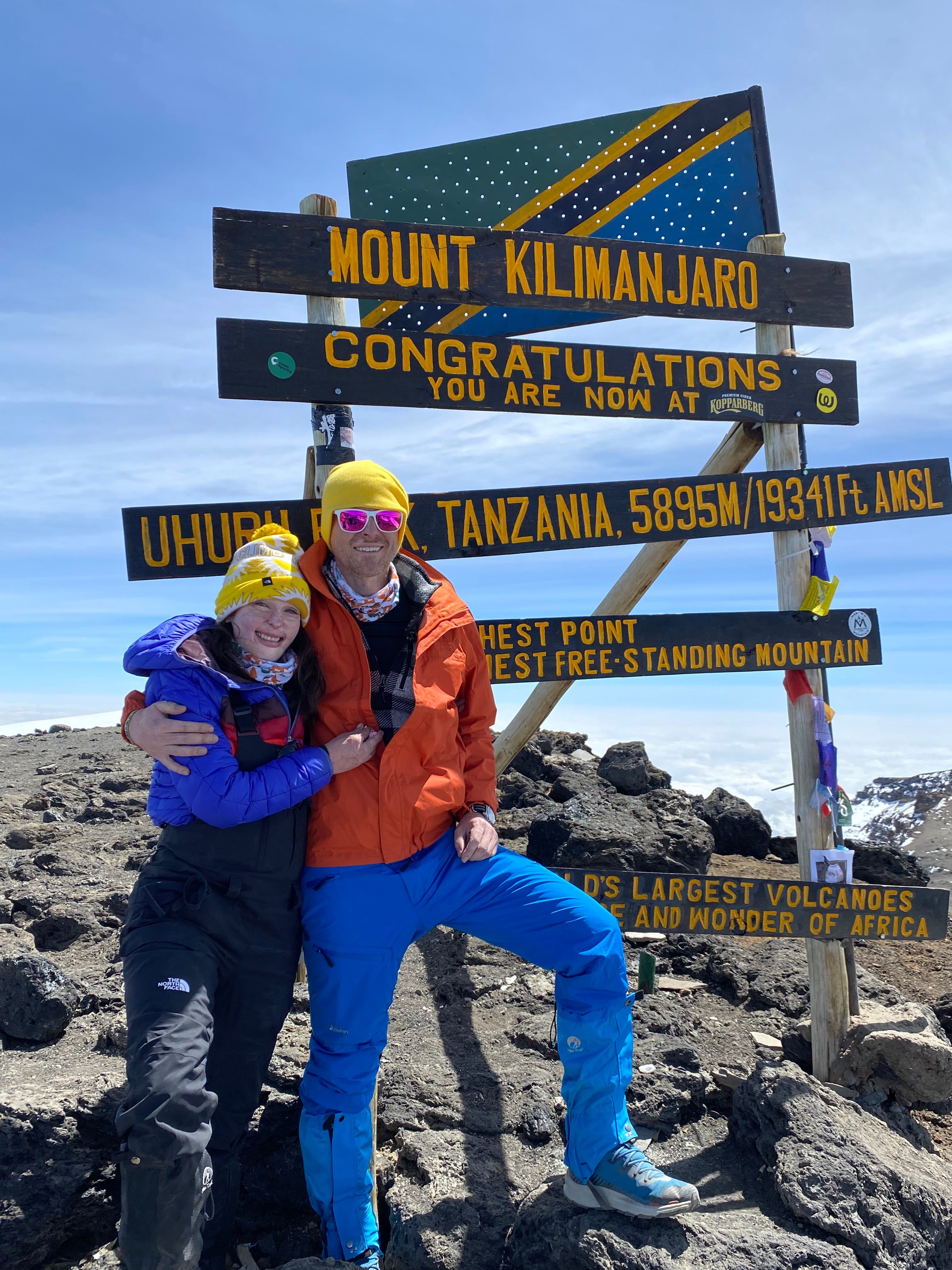
She and Christian get "a little weird" about going away together on big trips, she says.
"I think we might have just a little PTSD or something," she says. "Going on these adventures together, you know, we did that once and we didn't come back for a long, long time."
She worried her kids might be scared by the journey.
But they were elated, listening in on their mom and dad in planning Zoom calls and asking "Is there any room for us to go?"
As she looked out from atop Kilimanjaro, Stephanie hoped her kids would see the hike as an example of life's possibilities, what could be achieved with hard work and perseverance and help from others.
There was another thing, too.
Dr. Foster had been adamant from the start that the burn survivors would not carry their own packs. That duty would be handed to the dozens of porters who also made the trek, swelling Team Courage Rising's count of 47 to a party of more than 200.
It didn't sit right with Stephanie.
It was very freeing for me because I felt very included and I didn't have to worry at all about feeling ugly or, you know, any of those little insecurities that may creep up from time to time.
"I kept thinking, I had a baby after the accident," she says. "If I could carry a child for nine months, I'm pretty sure I can carry a pack on my back."
At a pre-hike physical, when Foster reminded her about the pack rule, she told him, "OK, sure." But on the first day, when a porter came to ask for her pack, she declined to hand it over.
"I wanted to carry my own load up the mountain," she says. It was symbolic for her, something she needed to prove. Just for herself.
Christian carried his own pack, too. "I knew Christian could, because he's so strong and able," Stephanie says. "But I wanted to do that."
And she did.
The hike had been freeing for Stephanie, who has burn scars on her face.
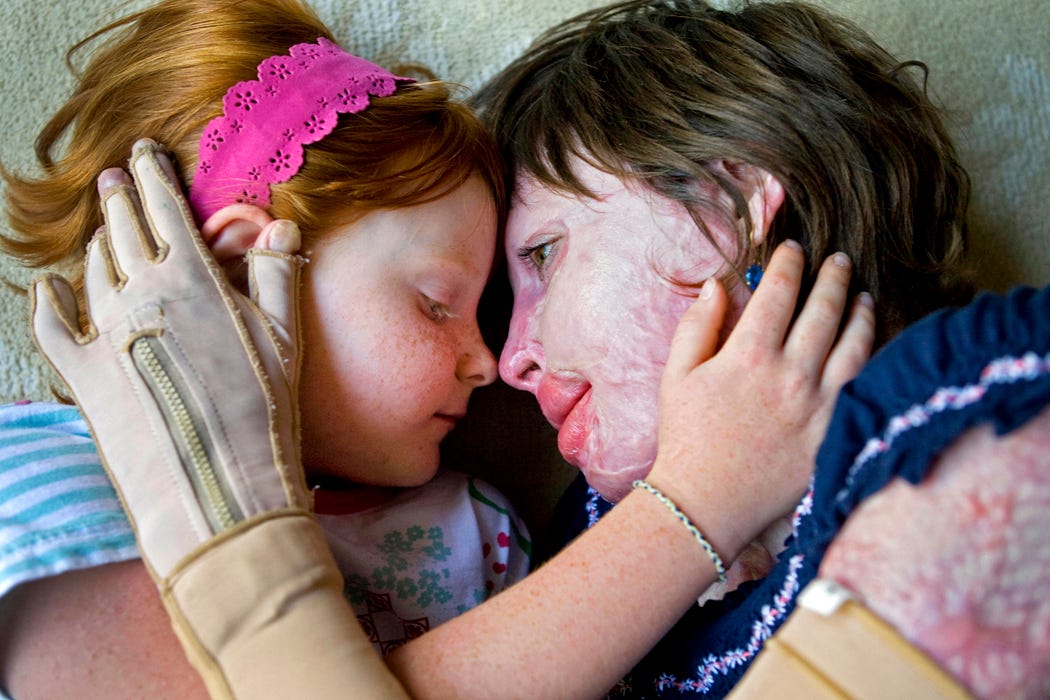
"Daily for me, I go and live my life and I go to the store and I go to church and I meet people," she says. "And it's always in the back of my head that I'm burned, that I look different."
She knows other people aren't necessarily thinking anything mean. But still, they notice. And she notices.
"I'm burned and they're staring at me and it's okay, right? I've moved on."
But on the mountain, Stephanie was among her people. She never felt embarrassed.
"It was very freeing for me because I felt very included and I didn't have to worry at all about feeling ugly or, you know, any of those little insecurities that may creep up from time to time," she says.
"I didn't feel that at all."
A long way home
Danika was right.
After reaching the summit, Isabella made it all the way back down.

"It was hard, I'll be honest," Isabella says. "Really hard."
After embracing her fellow survivors at Uhuru Peak, Isabella walked — or slid — the steep, rocky descent back to the previous night's camp, and took a break for lunch, the 7,000-foot descent still waiting.
"At that point I was like, what if we just stay at this camp? Deal with it tomorrow?" she says. "But we had to keep going. It was just taking it one step at a time."
At the final camp, she and Danika set their bags down in their tent and collapsed.
"We didn't even take anything out," Isabella says. "We just lay down."
All she could think about was tomorrow, the day she would walk off the mountain to a celebration, a hotel, a bed, and — most importantly — a shower.
The next day, she emerged from the rainforest between Danika and Dr. Foster. The three had found themselves walking together during the last part of the hike, along a road leading out of the greenery. It was, Isabella says, "the longest 20 minutes ever."
The moment was serendipitous, as unplanned as it was fitting, Isabella walking off the mountain with two of the most crucial people in her recovery.
'I'm embarrassed to admit it'
About two weeks later, Foster is sitting in his office at the Arizona Burn Center. He's wearing turquoise scrubs, a face mask dangling around his neck.
"I'm embarrassed to admit it," he says.
"I underestimated the burn survivors, which is something I'm not prone to do."
Hiking Kilimanjaro was extraordinarily hard, he says, the most difficult physical feat he has ever attempted.
"I didn't think it was going to be this hard," he says. "Or that it would consume this much time. I was actually looking forward to spending my afternoons sitting in the sun doing crossword puzzles and socializing with these people."
Instead, every day was spent hiking, each night collapsing with exhaustion in his tent.
Back in Phoenix, outside his office door, it's another busy day on the ward. Nurses and therapists in identical scrubs walk back and forth, tending to bandaged individuals who recently had their lives altered in an instant.
"We know what a bad day is really like," Foster says. "So it's kind of hard to complain about anything."
Foster was going to be a heart surgeon, but thanks to a mentor and a chance training opportunity, fell into the burn world. "The universe or God or karma was watching out for me because I definitely found my niche," he says.
People often say to him, "you must have a horrible job. It must be terrible working at the burn center."
"I'm like, what are you talking about?" he says. "I get to see the triumph of the human spirit on a daily basis."
How much harder is it for someone who has been through significant burn trauma to climb a mountain?
"Well, I'm not sure…" Foster begins. "I don't know that it is more difficult."
Receiving and recovering from a serious burn is "just shy of torture," he says. Just look at his patients.
Isabella spent close to a year of her childhood in a hospital, enduring agonizing skin grafts and stoically coping when an infection set back her recovery.
Stephanie and Christian's long road back to their kids involved months in the hospital and then in rehab, with multiple reconstructive surgeries after that.
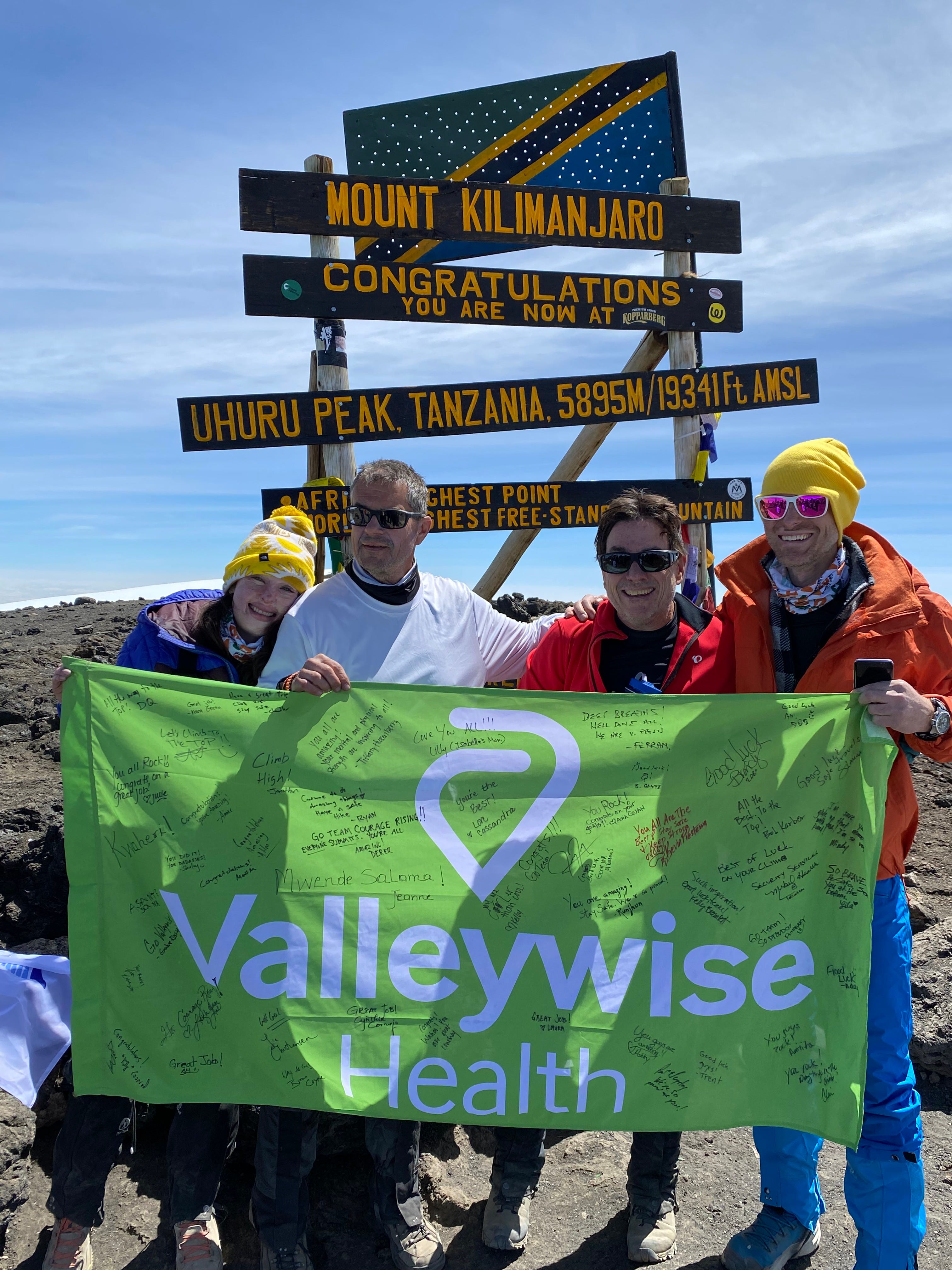
Christin wavered on the brink of death, as close as a person can get without actually dying.
"These people have all been through really, really huge stress tests. And what they have been through is something that an ordinary person really can't even conceive of, let alone go through," Foster says.
"So I think that they sort of self-selected themselves as being survivors and pretty tough people."
They have some physical limitations, the doctor allows. But the survivors have adapted to their scars, proved their strength and resilience.
"So, I think they might have been actually a little bit further ahead than the rest of us."
On Kilimanjaro, all eight survivors made it to the summit.
"It's a perfect metaphor for this place," Foster says. He got up from his office chair, fixed his mask and headed back out into the corridor.
He has patients to see. Survivors.
To date, Team Courage Rising has raised more than $350,000 for The Diane & Bruce Halle Arizona Burn Center, due to open October 2023. The money will go towards family support programs, burn research, equipment and programs for the pediatric wing, and more.
Reach the reporter at lane.sainty@arizonarepublic.com. Follow her on Twitter @lanesainty.